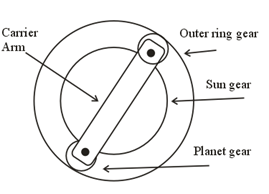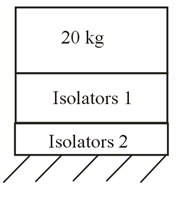Time Left - 12:00 mins
BARC 2019: Theory of Machines Nuclear Quiz-3
Attempt now to get your rank among 1195 students!
Question 1
In a snap action toggle mechanism, the mechanical advantage of the system is.
(the load makes an angle 10 degree with the horizontal x axis)
(the load makes an angle 10 degree with the horizontal x axis)
Question 2
A disc is attached to a circular rod having total moment of inertia about the longitudinal axis of the shaft which is coincident with the disc is I and k is the torsional stiffness of the shaft and  is the small tosrsional displacement. the angular frequency of the shaft disc system in rad/s is given as
is the small tosrsional displacement. the angular frequency of the shaft disc system in rad/s is given as
Question 3
A frictionless gear train is shown in the figure. The leftmost 12-teeth gear is given a torque of 100 N-m. The output torque from the 60-teeth gear on the right in N-m is


Question 4
What should be the angle between the two cylinder V line engine such that all the primary and secondary forces as well as couples are perfectly balanced.
Question 5
The variation in centre distance in involute gear caused due to vibration doesn’t violate the law of gearing(Velocity ratio remains constant). The reason for this phenomenon is _________.
Question 6
A single degree of freedom mass-spring-viscous damper system with mass m, spring constant k and viscous damping coefficient q is critically damped. The correct relation among m, k, and q is
Question 7
For two wheels of equal size with 200 pressure angle and the addendum equal to one module, the minimum number of teeth on each wheel to avoid interference must be.
Question 8
Following data relate to a gear in mesh.
Module=4mm
Number of Teeth=75
Base circle radius=141mm
The pressure angle ’ ϕ’ will be (in degrees)__________(in nearest integer).
Module=4mm
Number of Teeth=75
Base circle radius=141mm
The pressure angle ’ ϕ’ will be (in degrees)__________(in nearest integer).
Question 9
An epicyclic gear train is shown schematically in fig. The number of teeth on sun gear and outer ring gears are 50 and 100 respectively. The speed of arm when the outer ring gear is fixed and the sun gear rotates at 50 rpm clockwise is ____.

Question 10
The two slabs of isolators 1 and 2 are in series and are kept between a 20 kg solid body and the floor. The isolator 1 has a stiffness of 2000 N/m and a viscous damping coefficient of 80 N-sec/m. the isolator 2 has a stiffness of 5000 N/m and a viscous damping coefficient of 200 N-sec/m. The damped natural frequency (in rad/s) of the system in vertical direction is (neglect the mass of isolators) 

- 1195 attempts
- 3 upvotes
- 8 comments
Oct 16ESE & GATE ME

